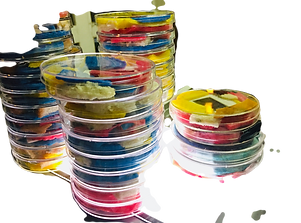HOW TO TRANSFORM NORMAL DIAPOSITIVE INTO PIECES OF ART?
The gelatin binder of photographic film is an emulsion of light-sensitive chemicals (silver halide), colourants and collagen tissues. These tissues are made of proteins coming from the skin or bones of animals, usually cows. They provide food to microorganisms in the surrounding environment. To cut a long story short, enzymes travel through the cell wall, breaking the protein so that the tiny subunits are absorbed into the cell, which then clones itself. Their proliferation is only possible if they are stored in hot, humid environments (above 65% relative humidity).
Thus, fungus has happily proliferated by slowly feeding on the protein gelatin covering the plasticized surface of the films (collagen). On some images, traces of the original photography remained visible while on a majority of them the shapes and colors were altered in a chaotic, spectacular, artistic way. A biological remix.
The key component to proliferate the fungus is the water and an high humidity environment. After various types of tests we realize that the best setup was a petri box with a sponge filled with water to keep the right level of humidity.
Mould have been cultivated, and standard (well preserved) diapos were either put in contact or closely exposed into this mould-accelerator environment. After an initial period of few weeks, the mold started to grow and the slides were then positioned on top of it. Using the correct combination of humidity and temperature ended up with some films decomposing themselves at daily speed!




The effect of this degradation is quite the same as the CERN corroded slides collection and the unpredictable (chaotic) transformation can sometimes result in beautiful combinations of shapes and colours.
This small-scale experiment gives nice results and we get a nice reproducibility of the mould process.
TIME LAPSE VIDEOS
We try to make a time lapse video, unfortunately the excessive level of humidity create the condensation on the petri-box.
This video takes 1.5 months, at the end you can see the degradation due to the mould.

On the right, there is the result of a similar sample after 1.5 months, humidity of the sponge was perfect. More time lapse video are going on, soon new results will be published.
